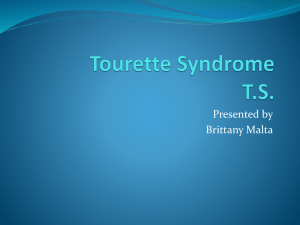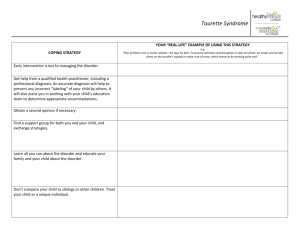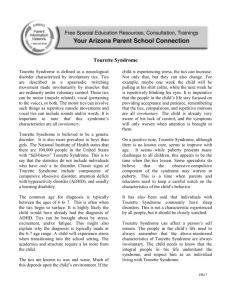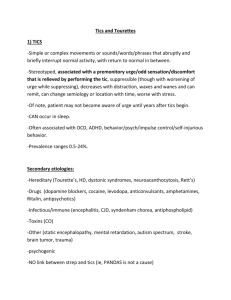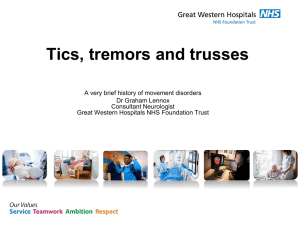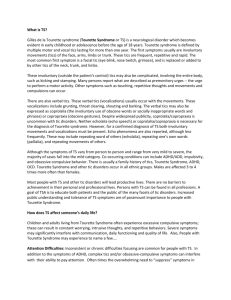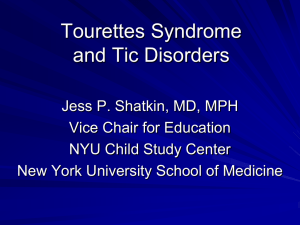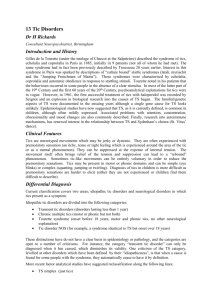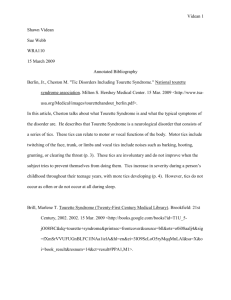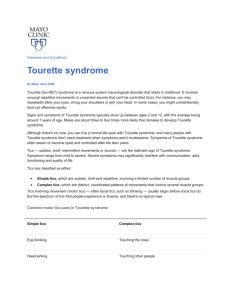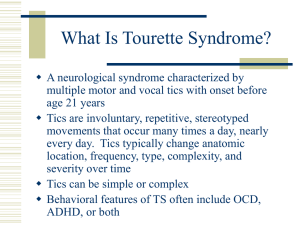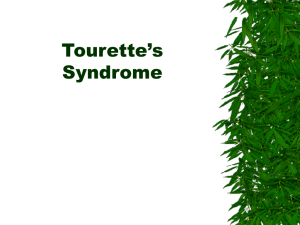Tourettes
advertisement
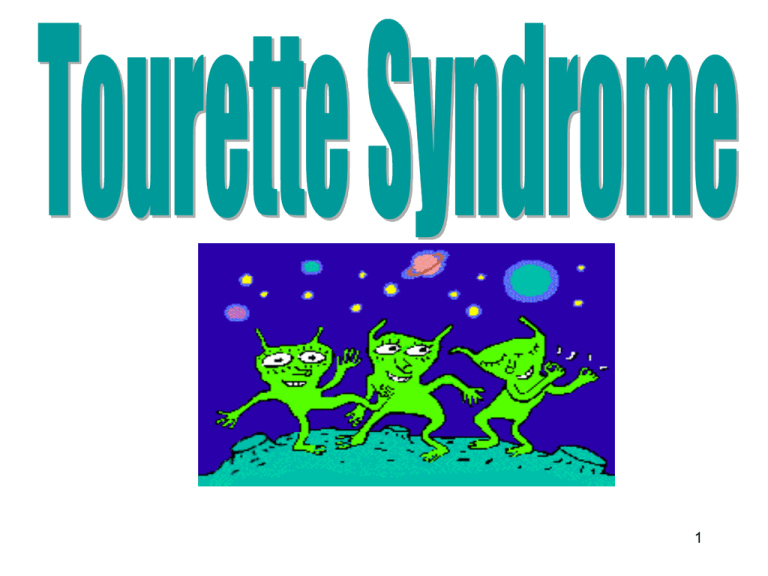
1 Vocabulary 1. 2. 3. 4. 5. 6. 7. 8. 9. 10. Tics are repetitive brief, stereotypical movements or vocalizations SLD is specific learning disability (e.g., in math, reading) TS is tourette syndrome Invariant mean without change Prescient feelings are warning signs that are thought to be perceptive or clairvoyant Copralalia is using obscene or socially inappropriate words Palilalia--the repetition or echoing of one's own spoken words, and may sound like stuttering.”Do my work work work” Echopraxia is involuntary repetition or imitation of the observed movements of another Echolalia is the repetition or echoing of the last sounds, words, phrases of another; these can be immediate or delayed Dopamine is a chemical which helps transmit signals from one nerve cell in the brain to the next. 2 Look at these links •http://www.tsa-usa.org/ •http://www.tsa-usa.org/news/HBO_Release_apr06_update.htm Self-reports: “I was devastated when I found out I had TS. I thought I was going to be a normal boy. But I’m not. My life is awful. I feel like I’m missing out on a lot of things because of my tics. I will feel a lot better if my tics go. If they don’t I will learn to put up with them.” (Neil, 9yrs) “My teacher treats me like an angel and manages my TS really well. The other students try to be understanding as my teacher has told them all about TS.” (Neil, 9yrs) “I used to get asked why I blinked all the time and everyone used to get angry at me because I couldn’t help looking at them and I always get harassed.” Lyle who is 9 years has Aspergerg and TS, and says he feels like he’s in prison when he is at school. 3 Definition A physical disorder of the brain characterized by multiform, frequently changing motor and phonic tics: 1. involuntary movements (motor tics) 2. involuntary vocalizations (vocal tics) First described by Gilles de la Tourette: 4 Tourette Syndrome (TS) Diagnostic Criteria DSM IV diagnostic criteria: 1. Presence of both motor and phonic (vocal) tics 2. Occurrences many times a day, nearly every day, usually in clusters, for longer than 1 year and not due to substance abuse or medications 3. Onset before 18 years 4. The disturbance is not due to the direct effects of a substance or general medical condition (must rule out TBI, brain tumors, epilepsy, autistic disorders, muscular dystrophy, CP, Parkinson’s, etc.) 5 Idea Category • Tourette Syndrome (TS) is now listed as a disability under the category of Other Health Impaired (OHI). 6 Prevalence 1. 1 in 1000 children; 10 times more frequent in childhood than adulthood. 2. Symptoms visible by 7, but signs as early as 2-5 years (Crawford et al., 2005) 3. Boys outnumber girls 3 to 1(Clarke et al., 2001) 7 CO-OCCURRENCE When TS accompanied by other disorders it is called Tourette’s Plus (Lue, 2001). 1. 50% have OCD symptoms 2. 50% have ADHD 3. 25-35% have tantrums and aggression (aggression occurs more frequently in TS, if the child already has hyperactivity, impulsivity, or ADHD) 4. 33% have SLD Boys more likely to have tics, and girls to have OCD symptoms; Sleep disorders are fairly common – Frequent awakenings 8 – Walking or talking in one’s sleep ETIOLOGY 1. Heredity: 50-70% of diagnoses of TS have hereditary base With one parent with TS, a child has a 50% chance of inheriting TS Identical twins may have tics that differ in intensity and frequency and non-genetic factors underlie these differences. 2. Biochemistry: An excess of, or oversensitivity, to dopamine. 3. Environmental factors: a. Caffeinated beverages, cough syrup, recreational drugs, diet medication, hay fever, allergies, or viral illnesses increase tics, which occur less frequently during sleep or activities that absorb the child’s concentration. b. Anxiety, anger, fear, or frustration increases tics 9 MOTOR CHARACTERISTICS Motor tics are defined as purposeless movements that range from simple to complex: MOTOR Simple: 1. blinking eyes (most common) 2. jerking neck 3. shrugging shoulders 4. flipping head 5. kicking 6. tensing muscles 7. sticking tongue out 8. finger movements MOTOR: Complex: 1. 2. 3. 4. 5. 6. facial gestures (eye rolling) grooming behaviors smelling things touching (other people or things), tapping jumping, squatting, retracing steps, deep knee bends, twirling when walking 7. hitting, biting 8. rarely are there self injurious actions such as hitting or biting one’s self. 9. Echopraxia 10.Copropraxia (Woods et al., 2003) 10 Motor Characteristics MOST develop: 1. eye tic first 2. facial tics or involuntary sounds 3. others within weeks or months • common examples: head jerks, grimaces, hand-toface movements Symptoms can: 1. change over time 2. vary (frequency, type, location, or intensity) 3. increase in intensity during early adolescence (12-15 years) 4. improve in less extreme cases during adulthood 11 VERBAL CHARACTERISTICS VOCAL: Simple: 1. throat-clearing 2. sniffing 3. coughing 4. grunting 5. spitting 6. yelling 7. belching VOCAL: Complex: 1. animal sounds 2. repeating words or phrases out of context “oh boy” “I don’t know” 3. Coprolalia 4. Palilalia 5. Echolalia They may “hear” a word or sound coming into their mind and feel they have to ‘say” it. 12 Communication • Stuttering • Coprolalia (fewer than 15% have this) – Occurs in late childhood – Most disruptive and disturbing (Jay, 2000) 13 Social Emotional Characteristics •The social and emotional difficulties that accompany TS are more problematic in day-to-day adaptations than are the motor and phonic tics (Carter et al., 2000). Children are teased and made to feel stupid, different and unwanted. Peers negative responses to tics can cause anxiety, which in turn increase tics and generate self-doubt. Adolescence is a period with strong emphasis on physical attractiveness. TS results in greater psychopathology during this period than any other (Chang et al., 2004) •Children also report uncomfortable, nervous, weird feelings (fear, disgust, doubt) or like they are going to explode before an onset of tics (Walter & Carter, 1997). •Overall there is a higher risk of: 1.poor peer relationships 2.no relationships 3.withdrawn or aggressive social behavior 14 Cognitive Characteristics Same IQ Visual-Motor and Perceptual Difficulties 1. Writing difficulties 2. Perceptual problems (Chui et al., 2000; Shannon, 2003)) 15 Academic Characteristics Tics potentially affect control of muscles involved in task performance. Children are able to suppress for limited periods of time, which increases as they age, but it does take great effort away from the task at hand (Walter & Carter, 1997) 16 Academic cont. Tics can make simple routine activities difficult (Chui et al., 2000) Difficulties with: 1.organization 2.long written assignments 3.copying from the black board 4. completing assignments on time and neatly (Walter & Carter, 1997) More likely to have SLDs: 1.Reading difficulties 2.Mathematical difficulties 17 Academic Accommodations General Principals: 1.Tics increase as a function of stress and calling attention to tics increases them. 2. Tics decrease with relaxation or when focusing on an absorbing task (Shannon, 2003). 18 Accommodations 1. 2. Model tolerance and do not allow teasing by peers Try various seating arrangements (Wilson, Jeni. Shrimpton, Bradely. 2003). Allow: 1. 2. 3. 4. 5. short breaks (e.g., break long assignments into smaller parts) movement around the room or outside the room (e.g., a fictitious note to the office) access to a private room with a bean bag chair--have a private signal exams in a private room for tension and tic release and allow more time child to tape oral presentations & reports (Lue, 2001) 19 INTERVENTIONS Pharmacological interventions increase success (Clarke et al., 2001). 1. Anti-tic drugs block the activity of the neurotransmitter dopamine. 2. Anti-OCD drugs help to restore the brain chemical serotonin, which reduces unwanted, thoughts. (Many people choose tics over the medications because of side effects, which are sleepy, gain weight. In addition no medication has been found that eliminates tics completely.) 20 Functional Analysis of a Student with Tourette Syndrome and a Mild Intellectual Disability 21 1. 2. 16 years old 3. Diagnosed with Tourette’s in early elementary school. Showed noticeable tics such as eye blinking and barking like a dog. 4. Diagnosed in the 5th grade as a child with a mild mental disability 5. In his school work, Chris always completes any activity or assignment given to him. Almost compulsive about completing assignments 6. Chris does not interact with his peers. Seeks adult interaction Originally diagnosed with ADHD and still carries that label 22 1. Enjoys helping others 2. Takes initiative in completing tasks 3. Good memory 4. Good attention to details 5. Has a strong desire to learn and do what is right 23 1. Difficulty with peer relationships 2. Poor fine motor skills including handwriting 3. Struggles with math and language arts 24 1. Random talking that is unrelated to subject or task and includes asking questions about upcoming events 2. Pacing 3. Withdrawn and Pouting 4. Yelling 25 26 1. Changes in students daily schedule: 2-hr. school delays, lack of aide in class, early dismissals, late bus arrivals. 2. Unstructured activities (breaks and times when waiting to load buses) 3. Structured but stressful activities: working on art project, visit to the high school, academic work in the resource room 27 28 Antecedent that caused the most behavior Changes in Students Daily Schedule 46% Behaviors that were seen the most Random talking/asking questions 58% Pacing 21% Payoffs earned the most Get self-determination (predictability) 85% 29 Diagnosis of Tourette’s? •Chris’ diagnosis of Tourette’s syndrome is correct. •He meets all of the criteria for a diagnosis a. Although his tics have dissipated, he still shows motor tics including eye blinking and head jerking. b. Research shows that it is common for children to see a reduction in the tics as they get older. Chris’ onset was in his early elementary years. c. Chris shows TS, which includes social and academic impairments 30 Diagnosis of ADHD? Although ADHD can be a comorbid condition of TS, we must first determine whether his co-occurring learning disabilities and mild mental retardation might not better explain his inattentive behavior. Follow-up: a. Now that he is given schoolwork based on his level of reading, language, and math, Chris is able to listen and sustain attention during his academics periods. b. He remains in his seat during class, never runs about the room, does not blurt out answers, and is able to wait his turn. Conclusion: Chris is not ADHD; he has a mild intellectual disability 31 Diagnosis of OCD? Chris’s OCD is a comorbid condition of the TS •Chris’ obsessions and compulsions have to do with checking, ordering, repeating, and getting things ‘just right’ rather than trivial concerns with contamination, something bad happening, or being neat and clean. •Chris’s obsessive/compulsive behaviors are connected to an event in a realistic way and help him to neutralize the unpredictability of the event. 32 Accommodations To address the child’s need for predictability and self-determination, teachers must provide: 1. A stable daily routine/schedule 2. Advance warning of any changes 3. Opportunities to ask questions as this is his way to reassure himself about a situation that is making him feel stressed and anxious 4. An escape, if needed, to regain control 33 Interventions To address the Chris’ need for self-determination, Chris must learn: 1. That when he cannot regain control, to be patient and ask for short breaks 2. To use scripts to interact with his peers. (For example, Chris does not know how to initiate a conversation; he only uses statements and needs to learn to ask questions.) 34 References Bagheri, M. M., Kerbeshian, J., & Burd, L. (1999). Recognition and management of Tourette’s syndrome and tic disorders. American Family Physician, 59, 2263-2274. Budman, Cathy, (2000, Oct.). Explosive outbursts in children with Tourette’s Disorder. Journal of the American Academy of Child and Adolescent Psychiatry, (need volume and page numbers) Carter, A., O’Donnell, D., Schultz, R., Scahill, L., Leckman, J., & Pauls, D., (2000). Social and emotional adjustment in children affected with Gilles de la Tourette’s Syndrome: Associations with ADHD and family functioning. Journal of Child Psychiatry, 41, need page numbers Chang, H., Tu, M., & Wang, H., (2004). Tourette’s Syndrome: Psychopathology in adolescents. Psychiatry and Clinical Neurosciences, 58, 353-358. Chiu, N., Chang, Y., Lee, B., Huang, C., & Wang, S., (2001). Differences in Tc-HMPAO brain SPET perfusion imaging between Tourette’s Syndrome and chronic tic disorder in children. European Journal of Nuclear Medicine, 28, need page numbers Chowdhury, Uttom, & Christie, Deborah, (2002, Sept.). Tourette's Syndrome: A training day for teachers. British Journal of Special Education, 29, 123-26. Clarke, M., Bray, M., Kehle, T., & Truscott, S., (2001). A school-based intervention designed to reduce the frequency of tics in children with Tourette’s Syndrome. School Psychology Review, 30, need page numbers Crawford, S., Channon, S., & Robertson, M., (2005). Tourette’s Syndrome: Performance on tests of behavioral inhibition, working memory and gambling. Journal of Child Psychology and Psychiatry, 46,1327-1336 Evidente, Gerald Virgillio, (2000, October). Is it a tic or Tourette’s? Postgraduate Medicine Online, 108, need page numbers Hendren, Glen, (2002). Tourette's Syndrome: A new look at an old condition. Journal of Rehabilitation, Need Volume and April-June need page numbers 35 References cont. Jay, T., (2000). Why we curse. Philadelphia, PA: Benjamins, need edition and page numbers? Lue, M. S., (2001). A Survey of Communication Disorders for the Classroom Teacher. Needham Heights, MA: Allyn, need edition and page numbers? Rowland, Belinda, (need year). Tourette's Syndrome. Gale Encyclopedia of Alternative Medicine, (need edition and page numbers) Shannon, J. B., (2003). Movement Disorders Sourcebook. Detroit, MI: Omnigraphics, need edition and page numbers? Sukhodolsky, Denis (2003, Jan.). Disruptive behavior in children with Tourette’s Syndrome: Association with ADHD comorbidity, tic severity, and functional impairment. Journal of the American Academy of Children and Adloescent Psychiatry, (need edition and page numbers) Truscott, S. (2001). A school-based intervention designed to reduce the frequency of tics in children with Tourette’s Syndrome. School Psychology Review, 30, 11-21. Van Borsel, John, & Vanryckeghem, Martine, (2000, May). Dysfluency and phonic tics in Tourette's Syndrome: A case report. Journal of Communication Disorders, 33(3), pp. 227-240. Walter, A. L., & Carter, A. S., (1997). Gilles de la Tourette’s Syndrome in childhood: A guide for school professionals. School Psychology Review, 26 (1), need page numbers Wilson, Jeni, & Shrimpton, Bradley (2003). Planning learning for students with Tourette's Syndrome. Student Disability Conference. Wodrich, David (1998, autumn). Tourette’s Syndrome and tics relevance for school psychologists. Journal of School Psychology, 36(3), pp. 281-294. Woods, D. W., Koch, M., & Miltenberger, R. G., (2003). The Impact of tic sverity on the effects of peer education about Tourette’s Syndrome. Journal of Developmental and Physical Disabilities, 15 (1), page numbers Woods, D. W., Twohig, M. P., Flessner, C. A., & Roloff, T. J., (2003). Treatment of vocal tics in children with Tourette's Syndrome: Investigating the efficacy of habit reversal. Journal of Applied Behavior Analysis, 36, pp. 109-112. 36
